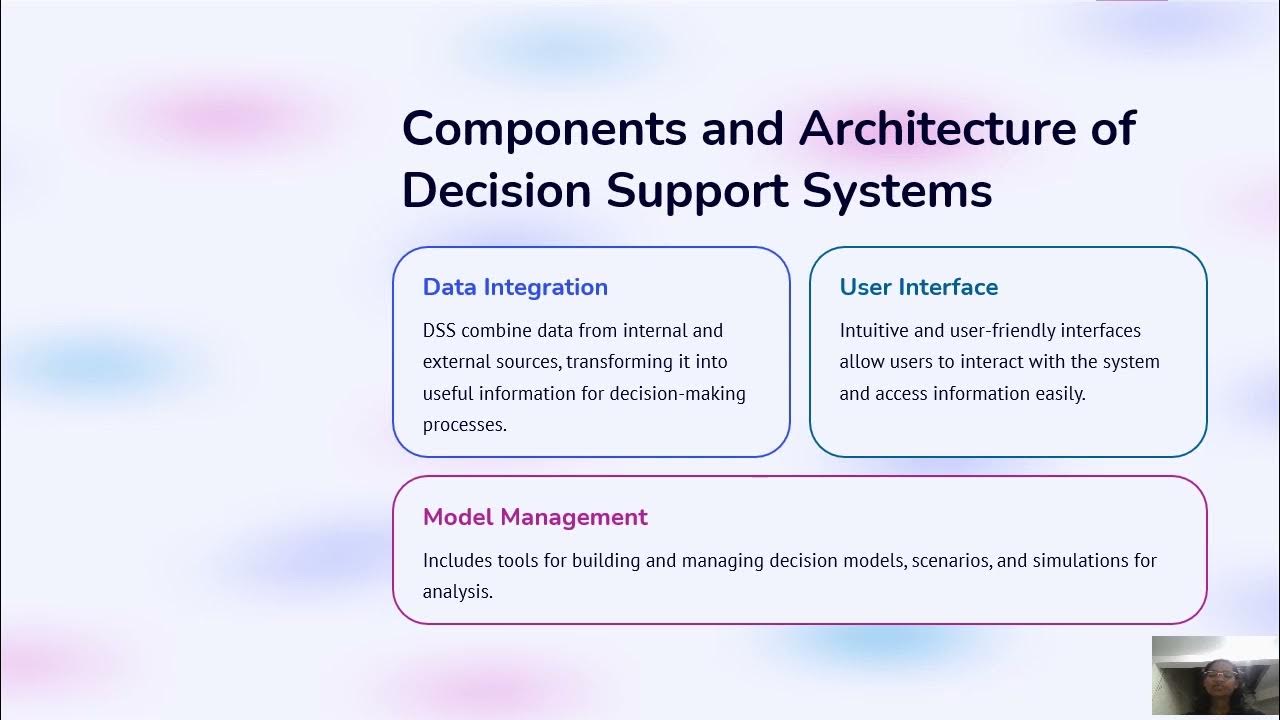Overview DSS
Summary
TLDRThis video explains the concept of Decision Support Systems (DSS), covering their definition, evolution, components, and methodologies. DSS, which supports decision-making for both structured and semi-structured problems, has evolved from its early definitions in the 1970s. It includes key subsystems such as data management, model management, user interfaces, and knowledge management. The video also highlights the capabilities of DSS, including flexibility, collaboration, and adaptability, as well as its application in enhancing decision accuracy, timeliness, and quality. Overall, it demonstrates how DSS aids decision-makers at all levels in both individual and organizational contexts.
Takeaways
- 😀 DSS (Decision Support System) is a system designed to support decision-making, especially in situations with semi-structured or unstructured problems.
- 😀 The main goal of DSS is to support and enhance decision-making processes by providing relevant data and analysis tools.
- 😀 DSS has evolved over time, starting in 1971, with definitions shifting to focus more on the input process rather than output, due to challenges in measuring decision outcomes.
- 😀 DSS utilizes models and data to support decision-makers through a flexible, interactive, and adaptive process.
- 😀 Web-based DSS architectures use a multi-tier system where a web browser interfaces with an application server and a data server, allowing data analysis and decision support remotely.
- 😀 DSS supports decision-making across all organizational levels, from executives to line managers, providing tailored decision support for different roles.
- 😀 One of the key features of DSS is the ability to handle interdependent or sequential decisions, which may require multiple iterations or feedback.
- 😀 DSS is adaptable over time, allowing decision-makers to react quickly to changing conditions and modify models to address new problems.
- 😀 User-friendly interfaces, often graphical and intuitive, improve the effectiveness of DSS, making complex decision-making processes easier to navigate.
- 😀 The main components of DSS include data management subsystems, model management subsystems, user interfaces, and knowledge-based subsystems, each playing a key role in the decision-making process.
Q & A
What is a Decision Support System (DSS)?
-A Decision Support System (DSS) is an interactive, flexible, and adaptive system designed to assist decision-makers in solving complex, unstructured problems. It supports decision-making processes by using data, models, and user interfaces.
What are the main characteristics of a DSS?
-Key characteristics of DSS include the ability to handle semi-structured or unstructured problems, support decision-makers at all levels, provide information for both individuals and groups, support interdependent decisions, and adapt over time as conditions change.
How has the definition of DSS evolved over time?
-The definition of DSS has evolved from focusing on supporting decision-making for unstructured problems to emphasizing flexibility, adaptability, and interaction with decision-makers. Earlier definitions concentrated on DSS as a tool for decision support, while later definitions focus more on inputs, such as data and models, rather than outputs like decision quality.
What are the components of a web-based DSS architecture?
-A web-based DSS architecture typically includes a web browser for accessing the system, a web server to handle requests, an application server to run the DSS program, and a data server that stores relevant data. These components work together to provide decision support by using data models and optimization techniques.
What role does flexibility play in DSS?
-Flexibility in DSS is crucial as it allows users to modify the system to meet changing conditions or solve similar problems. DSS should be adaptable, enabling decision-makers to add, remove, or adjust models and data as needed.
Can a DSS be used by individuals or entire organizations?
-Yes, DSS can be used by a single decision-maker at one location or by multiple users across various locations. For example, a DSS can be web-based, allowing widespread access within an organization or even across different organizations.
What types of problems does DSS typically address?
-DSS is designed to address semi-structured or unstructured problems. These are problems that cannot be easily solved using standard procedures and often require human judgment and decision-making, supported by data and computational models.
What are the stages of decision-making that DSS supports?
-DSS supports all stages of the decision-making process, including problem definition, intelligence gathering, alternative design, choice selection, and implementation. It helps decision-makers at every step by providing relevant data and analytical tools.
What is the role of modeling in DSS?
-Modeling in DSS allows decision-makers to experiment with different strategies and configurations. Models represent real-world systems or processes and can be used to predict outcomes, test scenarios, and make more informed decisions.
What are the key subsystems in a DSS?
-A DSS consists of several subsystems: the data management subsystem, the model management subsystem, the user interface subsystem, and the knowledge management subsystem. Each of these supports different aspects of decision-making, such as data collection, model analysis, user interaction, and knowledge sharing.
Outlines

This section is available to paid users only. Please upgrade to access this part.
Upgrade NowMindmap

This section is available to paid users only. Please upgrade to access this part.
Upgrade NowKeywords

This section is available to paid users only. Please upgrade to access this part.
Upgrade NowHighlights

This section is available to paid users only. Please upgrade to access this part.
Upgrade NowTranscripts

This section is available to paid users only. Please upgrade to access this part.
Upgrade NowBrowse More Related Video

Pertemuan10 SIM-SPK

DECISION SUPORT SYSTEM / KELOMPOK 11

Sebuah gambaran: Konsep, Metodologi, dan Teknologi Sistem Pendukung Keputusan

Topik 3 : Karakteristik dan Arsitektur Sistem Pengambilan Keputusan

Introduction to Decision Support Systems in Business intelligence

Decision Support Systems Video Lecture - Business Intelligence Concepts, Tools, and Applications
5.0 / 5 (0 votes)